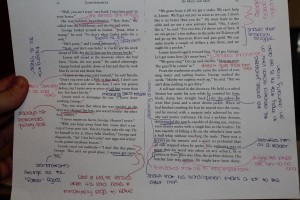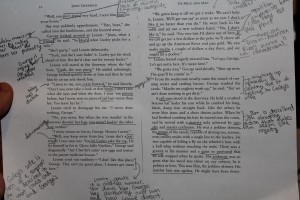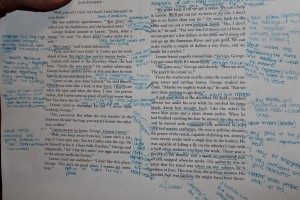What is annotation and why should I do it?
Your whole life you’ve been told NOT to write in books. Now I’m going to tell you to do the opposite. Why?
Annotations…
1)…make it easy to find important information quickly when you look back and review a text.
2)…help you familiarize yourself with both the content and organization of what you read.
3)…provide a interact with and understand what you are reading through comments, questions, associations, or other reactions that occur to you as you read.
In all these ways, annotating a text makes the reading process an active one, not just background for writing assignments.
A well-annotated text will accomplish all of the following:
•clearly identify where in the text important ideas and information are located
•express the main ideas of a text
•trace the development of ideas/arguments throughout a text
•introduce a few of the reader’s thoughts and reactions
modified from http://rwc.hunter.cuny.edu/reading-writing/on-line/annotating-a-text.pdf
When you are annotating, you are understanding more deeply, and you are studying and learning deeply without even really trying! This means that later on, you will have less work to do!
Here are some examples of annotated readings. You may choose to use more colors, highlighters, sticky notes, etc. to create your own system of annotation that makes sense to you.



Try using different symbols, for example:
- UNDERLINING: Underline (or highlight) all unfamiliar words. Later you can come back and write a synonym or brief definition of these words in the margins.
- ARROWS: Draw arrows within the margins to show how ideas relate to one another. (Maybe how supporting details connect to the main idea.)
- NUMBERS: Use numbers to indicate steps in a process, lists, important details, etc.
- QUESTION MARK: If something in the text causes you to ask a question, make a note of it in the margin.
- STAR or ASTERISK: Use this symbol if something stands out as important or interesting.
- EXCLAMATION MARK: Represent points you disagree with by writing an exclamation mark in the margin. (In a few words, jot down your contrary thought.)
- ABBREVIATIONS: Use your text-message spelling as shorthand notes (e.g., humorous parts with LOL).
- MARGIN NOTES: If something in the text causes you to have a comment, make a note of it in the margin. (This may include quick nutshell-summary notes.)


